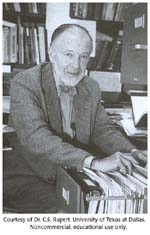Concept 28 Some types of mutations are automatically repaired.

 Claud Rupert did seminal research on light-activated DNA repair systems. Richard Setlow did a lot of the early work on thymine dimer repair.
Claud Rupert did seminal research on light-activated DNA repair systems. Richard Setlow did a lot of the early work on thymine dimer repair.
Claud S. Rupert (1919-2017)

Claud S. (Stan) Rupert was born in California in 1919 and grew up in a small farming town in the Central Valley. His father managed the local bank and his mother was a homemaker.
Rupert's mother's child-rearing skills included kicking him out of the house when he was moping. One day his mother ordered him to go to the library and get a book on astronomy. Rupert remembers the book was "kinda interesting" and reading it coincided with a total eclipse of the sun on April 28, 1930. Rupert decided to become an astronomer and a space traveler. In preparation for his imagined trips to Mars and Jupiter, Rupert wisely considered his food supply and calculated how many pounds of beans he would need to survive the trip.
In high school, a favorite science teacher gave Rupert extra projects to do, and he started playing with a refraction grating and spectroscopy. He continued to study physics in college at Caltech, although one year he got distracted with editing the school newspaper and failed a physics class. Thomas Hunt Morgan taught his only college biology class.
After retaking the physics class and graduating a bit behind schedule, Rupert worked for Lockheed while he decided what to do with the rest of his life. Airplane design wasn't it, though, and he thought engineering was "too organized. There was room for creativity but not my kind of creativity."
With World War II starting, Rupert had to contain his creativity for a while and he entered the Navy where he helped evaluate new radio and radar gear installed on ships. In the summer of 1946, Rupert left the Navy and started graduate school in physics at Johns Hopkins with money from the G.I. Bill. (Rupert had wanted to return to Caltech, but they were unable to get over that failed physics class.)
Rupert worked with John Strong on infrared spectroscopy for his Ph.D. research. He got hooked on biology when some people from the biology department approached him for help with a project on the effect of infrared light on flowers. Later, Roger Herriott and Sol Goodgal seduced him into their transformation lab where Goodgal came up with an idea to show that enzymes activated by visible light repaired damage to DNA.
Rupert attributes the success of that first experiment to luck. "Everything just happened to work. I made a mistake in getting competent cells and got ten times as many transformants, so that became the standard procedure."
Rupert continued to work on light-activated DNA repair for much of his career at the University of Texas at Dallas, where he moved after Johns Hopkins. His graduate student, Aziz Sancar, successfully purified and described the repair enzyme in the 1980s.
In 1989 Rupert retired from research and briefly became vice president for academic affairs before fully retiring. In his spare time, he and his wife enjoyed the theater and the symphony and volunteered to hold long-term care infants at the local hospital.


DNA repair enzymes were collectively honored as 1994's "Molecule of the Year" by Science magazine.

Your DNA repair mechanisms can not keep up with damage caused by overexposure to the sun. Does your sunscreen protect you from cancer-causing UV-A rays?
 DNA and proteins are key molecules of the cell nucleus.
DNA and proteins are key molecules of the cell nucleus. One gene makes one protein.
One gene makes one protein. A gene is made of DNA.
A gene is made of DNA. Bacteria and viruses have DNA too.
Bacteria and viruses have DNA too. The DNA molecule is shaped like a twisted ladder.
The DNA molecule is shaped like a twisted ladder. A half DNA ladder is a template for copying the whole.
A half DNA ladder is a template for copying the whole. RNA is an intermediary between DNA and protein.
RNA is an intermediary between DNA and protein. DNA words are three letters long.
DNA words are three letters long. A gene is a discrete sequence of DNA nucleotides.
A gene is a discrete sequence of DNA nucleotides. The RNA message is sometimes edited.
The RNA message is sometimes edited. Some viruses store genetic information in RNA.
Some viruses store genetic information in RNA. RNA was the first genetic molecule.
RNA was the first genetic molecule. Mutations are changes in genetic information.
Mutations are changes in genetic information. Some types of mutations are automatically repaired.
Some types of mutations are automatically repaired.